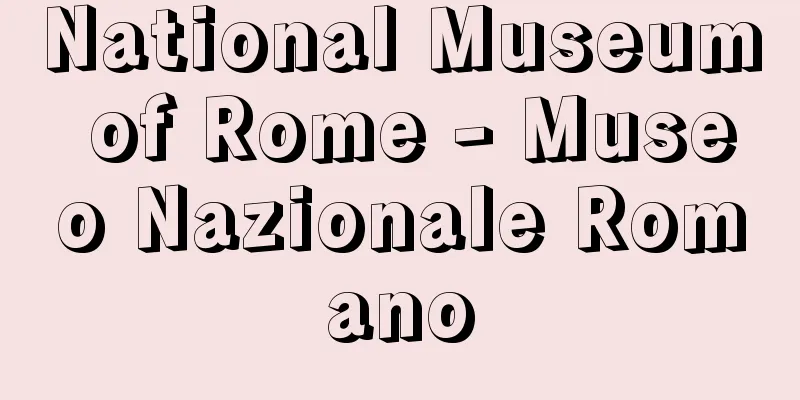National Museum of Rome - Museo Nazionale Romano

|
This museum in Rome is one of the most representative of the nearly 400 national museums in Italy. It is also called the Museo delle Terme di Diocleziano, as it uses part of the remains of the huge public baths (thermes) built by the Roman Emperor Diocletian in the early 4th century. The baths had fallen into ruins since the Goths invaded in the 6th century, but around the 16th century, when conservation and restoration work began, a Carthusian monastery was built using the plans of the ruins. The cloister of this monastery, centered around the Basilica of Santa Maria degli Angeli, is said to have been designed by Michelangelo. Although the ruins have been altered since then, they have retained the appearance of ancient Roman public architecture, and were nationalized in 1902. After that, it was renovated as a museum, and opened in 1911, the 50th anniversary of the unification of Italy. After the restoration of the baths was completed, the site and building itself, as well as the exhibits, became a museum of great archaeological and historical value. The museum's collection and exhibits are mainly Greek and Roman relics such as sculptures, sarcophagi, murals, mosaics, and crafts excavated in Rome and the Lazio region after the late 19th century, when Rome began to develop as a modern city, but it is also famous for its long history of private collections that were nationalized through donations and purchases. Among them, the Ludovisi Collection, which was collected by Cardinal Ludovico Ludovisi (c. 1595-c. 1632) and purchased by the state in 1901, includes the Greek classical relief "Ludovisi Throne," and the "Ludovisi Great Sarcophagus" from the late Roman Empire, which are representative of the museum's collection. Other important items in the collection include Greek sculptures such as "Apollo of the Tiber," "Juno of the Palatine," "The Daughter of Niobe," the "Pugilist" by Apollonius, and the "Maiden of Anzio," as well as numerous portrait sculptures, including the statues of Augustus on the Via Rubicana, Caesar, and Socrates. It also has what is said to be the world's largest collection of Roman sarcophagi, as well as wall paintings from the villa of Livia (wife of Augustus) at Prima Porta, wall paintings and stucco reliefs from the Villa Farnesina, and a huge pavement mosaic from Collemancio. These large collections are displayed in several buildings. The buildings within the Baths of Diocletian and the Aula Ottagona to the east of the baths house Greek and Roman sculptures, reliefs, paintings, mosaics, and medals excavated in Rome. Palazzo Massimo, next to the Piazza Five Hundred, displays ancient Roman works dating from the 1st century BC to the end of the Empire. Palazzo Altemps, close to Piazza Navona, houses the Ludovisi Collection as well as mosaics and sarcophagi. [Kenjiro Hosaka] [References] | |Source: Shogakukan Encyclopedia Nipponica About Encyclopedia Nipponica Information | Legend |
|
イタリアにある400近い国立館のなかでも代表的な、ローマにある美術館。4世紀初頭にローマ皇帝ディオクレティアヌスが建設した巨大な公共浴場(テルメ)の遺構の一部が使用されていることから、テルメ美術館Museo delle Terme di Dioclezianoともよばれる。浴場は6世紀にゴート人が侵入して以来廃墟(はいきょ)と化していたが、保存・修復の作業が始められた16世紀ごろには、遺構のプランを生かしたカルトゥジオ会の修道院が建設された。サンタ・マリア・デリ・アンジェリ聖堂を中心とするこの修道院の回廊は、ミケランジェロの設計とされる。遺構はその後も改変の手が加えられたが、古代ローマの公共建築の面影を保ち続け、1902年に国有化された。その後美術館としての整備が進められ、イタリア統一50周年にあたる1911年に開館となった。浴場跡の修復も一段落した後は、展示品のみならず敷地や建物そのものが、重要な考古的・歴史的価値をもった美術館となっている。 収蔵・展示されているのは、主としてローマが近代都市として整備され始めた19世紀後半以降に、ローマ市内およびラツィオ地方から出土した彫刻、石棺、壁画、モザイク、工芸などの古代ギリシア・ローマの遺品であるが、寄贈や買上げによって国有化された、歴史の古い個人コレクションもまた名高い。なかでも1901年に国家が買上げた、枢機卿ルドビコ・ルドビージLudovico Ludovisi(1595ごろ―1632ごろ)の蒐集(しゅうしゅう)になるルドビージ・コレクションに含まれるギリシア古典期の浮彫『ルドビージの玉座』や、ローマ帝政末期の『ルドビージの大石棺』などの古代美術品は、収蔵品を代表する作品となっている。そのほかの主要収蔵品には、『テベレのアポロン』、『パラティーノのユノー』、『ニオベの娘』、アポロニオス作の『拳闘士(けんとうし)』、『アンツィオの少女』などのギリシア彫刻、『ビア・ルビカナのアウグストゥス』像、『カエザル』像、『ソクラテス』像をはじめとする数多くの肖像彫刻、また世界最大といわれるローマ石棺のコレクションのほか、プリマ・ポルタのリウィア(アウグストゥスの妻)の別荘の壁画、ビラ・ファルネジーナ出土の壁画やストゥッコ浮彫(ストゥッコとは、漆喰(しっくい)の一種で消石灰を主材料にした凝固の遅いものをいう)、コレマンチオ出土の巨大な舗床(ほしょう)モザイクなどがある。こうした多数の収蔵品は、複数の建物に分かれて展示されており、ディオクレティアヌス浴場内の建物と浴場東側のアウラ・オッタゴーナには、ローマで出土したギリシア・ローマ時代の彫刻、浮彫、絵画、モザイク、メダルなどが、五百人広場わきのパラッツォ・マッシモには紀元前1世紀から帝政末期にいたる古代ローマ時代の作品が、ナボナ広場にほど近いパラッツォ・アルテンプスにはルドビージ・コレクションのほかモザイクや石棺などがある。 [保坂健二朗] [参照項目] | |出典 小学館 日本大百科全書(ニッポニカ)日本大百科全書(ニッポニカ)について 情報 | 凡例 |
<<: Roman Alphabet - Romaji (English notation)
>>: Sack of Rome - Sacco di Roma
Recommend
Royal Turaco - Royal Turaco
…On the other hand, the red feathers on the head ...
Müller von Bulgenbach, H.
… The Peasants' War began on June 23, 1524, w...
Union Officer - kumiai yakuin
This refers to a person who holds a leadership pos...
"The Port of Sakhalin" - The Port of Sakhalin
...Information from overseas brought by Qing merc...
Quatrefage, A.de - Quatrefage
… The first human bones to be recognized as fossi...
Dagestan peoples
The term refers to some of the peoples living in t...
Bluebeard - Aohige
1. After shaving your thick beard. 2. In Kabuki, t...
High-cost medical care expenses payment system
Medical expenses continue to rise due to advances ...
State monopolistic capitalism (English spelling)
In the stage of monopoly capitalism, where capita...
"Imosezuka Matsuni Sakura" - Imosezuka Matsuni Sakura
...Another work that incorporates the idea of &...
Uchimurasaki - Uchimurasaki
…A citrus fruit that is an evergreen tree in the ...
Haidú P.
...Others have pointed out its connection with th...
Gauranitis - Gauranitis
…It is a strategically important site located at ...
Rougemont (English spelling) Denis de Rougemont
Swiss author. Born in Neuchâtel, he wrote in Fren...
Water column meter - Water column meter
A unit of pressure. The symbol is mH 2 O or mAq. 1...









